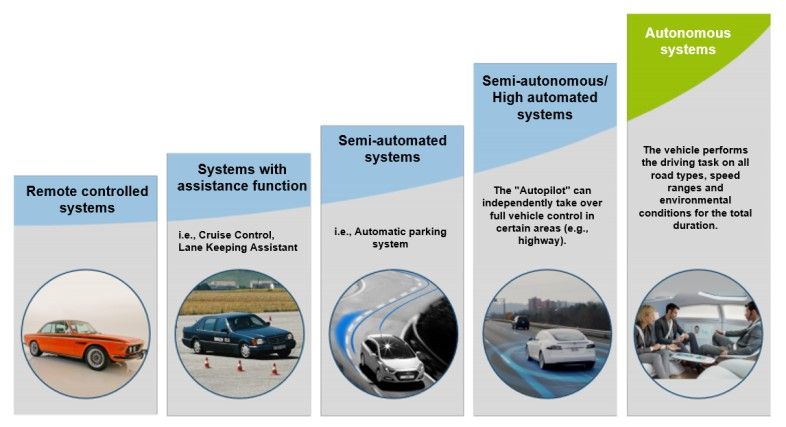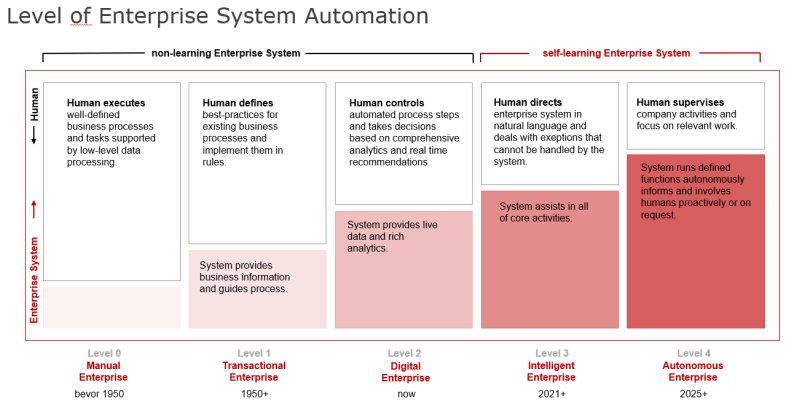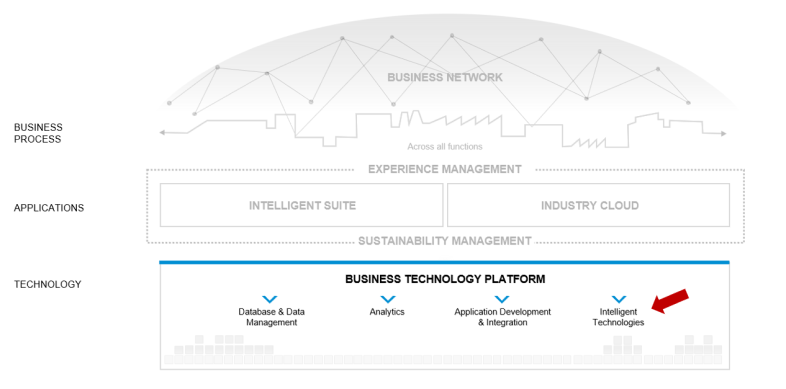How can intelligent technologies be cleverly used in your SAP S/4HANA system and in other SAP solutions? How do you get the optimum performance from these systems? We show which preconfigured packages (best practices) SAP delivers in this environment and what they bring about. Take a step toward the autonomous enterprise with our eight-part blog series.
Intelligent Technologies in SAP S/4HANA

Intelligent Technologies: Why are These so Important Right Now?
The terms “Intelligent Enterprise” and “Intelligent Technologies” have been heard often in the past two years and read in every IT magazine. Many companies have recognized the importance of these topics and are increasingly investing in innovative technologies. But most of the companies, especially from the midmarket, are still lagging when it comes to taking their hands off the wheel and letting the autopilot take over the “driving”. Why is that? It’s simple: the autopilot is not yet built in. The reasons are many, but there are similar situations that can be seen at many companies.
One of the challenges our customers face is that they spend a lot of time and effort to keep operations running. This is partly due to manual and paper-based business processes. Experience shows that the investment budget remains low with high operating costs, and companies get caught in a vicious circle because they can’t invest enough in automation.
Have the courage to break this vicious circle! Next-generation technologies can help you minimize operating costs. Many of the repetitive tasks you spend your time on today as a knowledge worker can be accelerated or replaced by automation tools. As a result, you will have more time for more demanding or creative tasks that lead to, for example, improved products and services.
Especially in the 2020/2021 pandemic, companies face another dilemma: they must protect employee health while keeping business processes running. Accordingly, it is success critical that hardware, such as machinery systems in the factory or material supply technology in the warehouse, and enterprise software continue to run as autonomously as possible with little human intervention.
So make your company at least semi-autonomous by automating business processes and digitizing production equipment. Incorporate smart technologies such as IoT, machine learning, blockchain, software robots, and digital assistants (chatbots and voicebots) into your processes. In this blog series, you can read how this also works for medium-sized companies and what role the SAP Intelligent Enterprise Framework plays in this.
Levels of an Enterprise System
For a better understanding of partially autonomous and fully autonomous ERP systems, I compare an ERP system with a car in the following. The following figure shows the development of a car to an autonomous vehicle . In the “partially autonomous” level, the vehicle takes full control for certain road types, and in the “autonomous” level for all road types.

Correspondingly, the levels of an ERP system can also be represented:

Comparable to an autonomous vehicle, the enterprise system at the highest stage of development takes full control and involves people proactively or on request.
Employees can focus on other relevant work during this time. Bots and embedded artificial intelligence handle many of today’s tasks that are repetitive on the one hand and very complex on the other, which humans can no longer control.
Intelligent technologies play a critical role in this. But many customers are asking: which technologies are right for me? How are they linked to SAP and non-SAP processes? Where do you start to automate processes? What best practices are already being delivered by SAP?
Before we dive into the details, I’d like to briefly discuss the SAP Intelligent Enterprise Framework to help you better understand the connections between individual SAP solutions and technologies.
The SAP Intelligent Enterprise Framework
The SAP Intelligent Enterprise Framework in its new extended form was introduced in 2020. It combines the Business Network, the Intelligent Suite, the Industry Cloud and the Business Technology Platform.

The SAP Intelligent Enterprise Framework is explained in detail here. It is first important to know where to find the intelligent technologies in the Intelligent Enterprise Framework.
Intelligent Technologies within the SAP Intelligent Enterprise Framework
Intelligent technologies are one of the four essential pillars of the Business Technology Platform. The other essential components are data management, analytics, and application development and integration.
With the help of innovative technologies and tools such as predictive analytics, machine learning (ML), artificial intelligence (AI), the Internet of Things (IoT), robotics process automation, and conversational AI, this intelligence is embedded in business processes and transformed into smart processes. The technologies will be made available through various channels. On the one hand, they are fully integrated into the individual SAP solutions, and on the other hand, they are provided side-by-side via the SAP Business Technology Platform. The latter variant is advantageous as the technologies can be integrated into both, SAP systems and non-SAP systems.

What is important in all of this is that you do not have to invest vast sums of money or adopt the entire SAP Intelligent Enterprise Framework in order to create added value from innovative technologies and tools. For noticeable automation gains, it is initially sufficient to select and implement individual technologies in a targeted manner. If a successful pilot project then triggers the digital transformation in your company – all the better. The technologies presented here can be built up successively and networked with each other at any time. Motto: “Think big, start small!”
Interested in Knowing More?
Then read on! You can find more on the topic of “Intelligent Technologies in the SAP S/4HANA Context” in our Intelligent Enterprise blog series:
- Part 1: Your Path to the Intelligent Enterprise: Intelligent Technologies in SAP S/4HANA
- Part 2: Intelligent Technologies as an Integral Part of SAP S/4HANA – An Overview
- Part 3: Conversational AI: Chatting and Speaking with the SAP S/4HANA System
- Part 4: Machine Learning: Predicting Delivery Date Delays in SAP S/4HANA with Embedded AI
- Part 5: Software Robots Relieve Your Customer Inquiry Management – How RPA Works